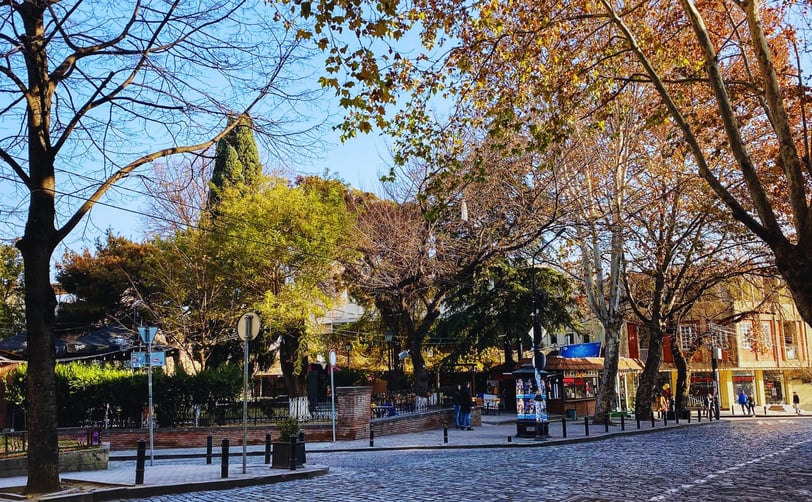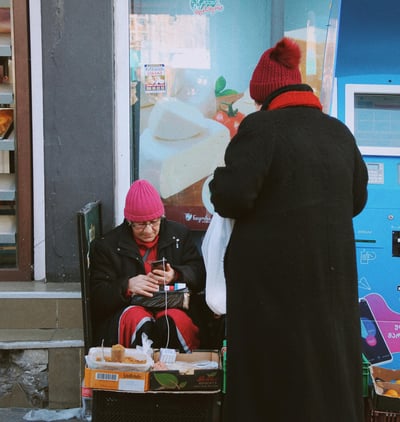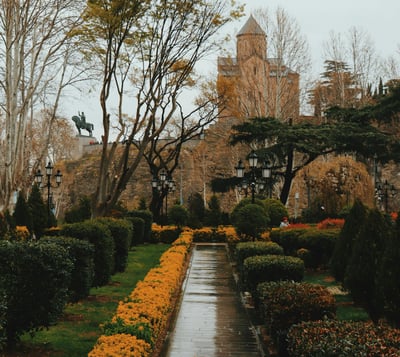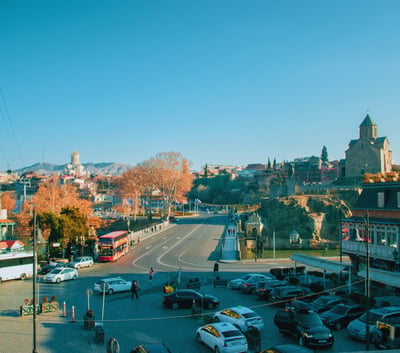Khachapuri and the Women of Rustaveli: A Tbilisi Tale


Every morning in Tbilisi begins with a kind of music. Not the kind that pours from cafés or crackles from taxi radios—but the quieter music of pans clanging, brooms sweeping, and old women greeting each other in Georgian like they’ve said the same words for forty years and still mean every syllable.
It was this soundscape that first pulled me from my hostel bed, just a few blocks off Rustaveli Avenue, where the city thrums with both old-world melancholy and young rebellion. The night before, I had wandered home through streets lit gold, drunk on cheap wine and city poetry. But now it was morning. And the air smelled of butter, salt, and something like home.
There, at the edge of the sidewalk across from the opera house, a group of elderly women had laid out their kingdom: folding tables, plastic stools, and worn baskets lined with cloth. On them sat loaves of khachapuri—round and steaming, their crusts golden, their bellies full of hot cheese and egg yolk still trembling. Some sold imeruli style, sealed like a pie; others offered adjaruli, shaped like boats and best eaten with your fingers.
But what drew me in wasn’t just the bread. It was the women.


They were wrapped in patterned headscarves, their hands weathered and sure, their eyes sharp. I was drawn to them with that hesitant energy of the outsider who wants to belong, but knows better than to pretend.
I returned every morning after that.
They began to let me in, in the quiet way of people who don’t need to explain themselves. They taught me to watch, to listen, to feel the rhythm of the avenue. I learned which buses roared too loudly and which pigeons belonged to which railing. I learned that khachapuri was best at 8:15 a.m. and worst after ten. I learned to tell the difference between tourists who looked and those who saw.
One of them noticed me hovering nearby. She had a mole beside her left eye and wore a dark green cardigan buttoned all the way to her throat. She looked me over like a schoolteacher scanning an unfamiliar student. Then she nodded once and patted the stool beside her. I sat.
Her name, I later learned, was Tamari. Like the ancient queen.
She handed me a piece of khachapuri, wrapped in parchment, and motioned for me to eat. The cheese was still warm and tasted like it had been waiting for me all my life. We didn’t speak much that first morning—only exchanged names, smiles, and one or two words about the weather—but something passed between us. A gentle permission. A welcome.


One morning, Tamari brought an old photo album in a plastic bag. She showed me black-and-white pictures of her as a young ballet dancer in Soviet-era Tbilisi. Another woman, Lela, once a schoolteacher, recited poetry from memory while shaping the dough. A third, the quietest one—Nino—ran a bakery during the war and had kept it open even on the day her husband didn’t come home.
Their lives were layered like the dough they worked with—folded, pressed, turned, and baked into shape.
The stories weren’t offered all at once. Some came in crumbs: a word here, a gesture there. Some were spoken in Georgian, others in Russian, and some with only the language of glances. But over days and pastries, I learned to read the silences too.
Lela once joked that every piece of khachapuri carried the spirit of a different neighborhood — Vera, Sololaki, Avlabari. “Even the dough has memory,” she said, brushing flour from her hands.
Some days, the women would talk about Freedom Square, or the grand parades they remembered as girls. They laughed about dances once watched at Marjanishvili Theatre, and how the soldiers always clapped too early. Occasionally, they’d gossip about someone from Dry Bridge Market, or argue over whether the best sunset was seen from Mtatsminda Park or the Chronicles of Georgia monument.
One morning, Tamari handed me a crumpled, yellowed page with a verse typed in faded Cyrillic.
“From the old days,” she said. “We copied them at night. Hid them in flour sacks. Read them by candlelight. It was not allowed to feel too much, then.”
It was part of the old “samizdat” network, she explained—when poetry traveled hand to hand, heart to heart, far from the eyes of censors.
The poem was about the river that runs through Tbilisi, and how even water could remember. She told me her sister once whispered poetry outside Metekhi Church, pretending to sell sunflower seeds while sharing lines from forbidden poets.


I asked them once why they chose to sell khachapuri on the street when they could have stayed home, or sent their grandchildren instead. Tamari just laughed.
“We don’t sell bread,” she said. “We offer memory.”
By mid-morning, their stalls would be almost empty, and the shadows shorter. I would walk with Tamari to the bus stop, sometimes carrying her empty basket. Once, I asked her if she missed the stage—the theater, the lights. She stopped walking and looked out toward the river.
“There are many kinds of stage,” she said. “Some need curtains. Some just need a morning.”
I never saw Tamari again. But I often think of her when I eat khachapuri, especially when I tear it with my hands and feel the warmth rise up like a whisper. I remember her smile, her silence, the grace in her movements. And the way she taught me that some cities don’t reveal themselves in landmarks or museums—but in women at the edge of sidewalks, with bread and memory in their hands.
On my last day in Tbilisi, I arrived a little later than usual. The women were there, as always, but Tamari’s seat was empty. Lela handed me a piece of khachapuri wrapped in a napkin and pressed something into my hand. It was a small, yellowed photograph of a dancer mid-leap, smiling toward the sky.
“She’s in Batumi,” Lela said. “Visiting her sister. But she wanted you to have this.”
I stood there for a long moment, watching the women laugh and speak and sell and tease one another. The city moved around them, fast and full, but they stayed rooted, like the trees lining Rustaveli—witnesses, keepers, storytellers.
From the Tale: A Short Glossary
Khachapuri: Georgia’s most beloved traditional bread—typically filled with hot, melted cheese and sometimes egg. Styles vary by region, from the pie-like imeruli to the iconic boat-shaped adjaruli, with its golden yolk cradled in the center.
Samizdat: A clandestine system of self-publishing used throughout the former Soviet Union to circulate censored literature, poetry, and ideas. Often typed by hand, passed from friend to friend, and hidden in the most unlikely places.
Rustaveli Avenue: Tbilisi’s central artery—a boulevard lined with theaters, monuments, bookstores, and daily life. Named after the 12th-century Georgian poet Shota Rustaveli.
Metekhi Church: A medieval church perched above the Kura River, known for its views, history, and quiet resilience through centuries of upheaval.
Dry Bridge Market: An open-air flea market in Tbilisi where one can find Soviet relics, old photographs, vintage jewelry, and the scattered memories of other lives.
Mtatsminda Park: A mountaintop amusement park with panoramic views of the city. Beloved by locals for its nostalgic charm and dizzying ferris wheel.
Chronicles of Georgia: A monumental and somewhat surreal collection of towering sculptures overlooking the Tbilisi Sea, depicting scenes from Georgian history and biblical tales.
To see the city beyond the scent of bread and memory, walk deeper into its winding lanes and steaming courtyards in Destinations — "Tbilisi: Where Sulfur Steams and Memory Dances."
✉️ Contact:
Curated by TrueTrip Hub |
© 2025 Invisible Atlas — All rights reserved.
Invisible Atlas
Journey Beyond the Visible
invisible.atlas@truetriphub.com
